Choosing the Right Grass for Your Lawn
Choosing the right grass type is essential for a thriving, cool-season lawn. Whether you need durability, shade tolerance, or low maintenance, here’s our guide.
Heartland Grounds
2/19/2025


If you’re looking to establish a healthy, resilient lawn in Iowa, selecting the right cool-season grass is crucial. These grasses thrive in our climate, handling cold winters and fluctuating Midwest temperatures while providing a lush, green appearance. However, different species have varying levels of shade tolerance, drought resistance, and durability against foot traffic. Below, we’ll break down the most common cool-season grasses used in Iowa, along with their key characteristics and best applications.
Why Iowa Needs Cool-Season Grass
Iowa's climate is characterized by cold winters and warm, humid summers, making cool-season grasses the best choice for maintaining a healthy lawn. These grasses thrive in the spring and fall when temperatures range between 60-75°F, which is ideal for growth. During the hot summer months, cool-season grasses may enter dormancy but will recover once cooler temperatures return. The deep root systems of some varieties, like Tall Fescue, help improve drought tolerance, while the spreading nature of Kentucky Bluegrass ensures durability and self-repair. By choosing the right mix of cool-season grasses, homeowners can maintain a lush, green lawn that stands up to Iowa’s variable weather conditions.
A well-balanced lawn often includes a mix of grass types to optimize performance under different conditions. For example, blending Kentucky Bluegrass and Perennial Ryegrass ensures a lawn that is both lush and quick to establish, while adding Fine Fescue can improve shade tolerance. Similarly, Tall Fescue is an excellent choice for properties with poor soil conditions or heavy traffic areas. Soil type also plays a key role in grass success—sandy soils drain quickly and benefit from deep-rooted grasses like Tall Fescue, while clay-heavy soils retain moisture and may better support Kentucky Bluegrass and Fine Fescue varieties. Understanding these factors can help create a lawn that is not only beautiful but also durable and sustainable.
Types of Cool-Season Grass in Iowa
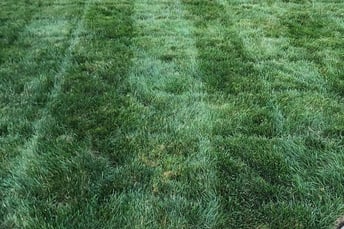

1. Kentucky Bluegrass (Poa pratensis)
Best for: Traditional lawns, full sun areas, and mixed grass blends.
Characteristics: Dense, medium-textured, and dark-green grass.
Growth Habit: Spreads via underground rhizomes, which help it recover from damage.
Identification: Boat-shaped leaf tip, smooth surface, translucent midrib lines.
Strengths: Good wear resistance, recovers well from damage, and has strong low-temperature tolerance.
Weaknesses: Slow germination and establishment, low heat tolerance, struggles in dense shade.
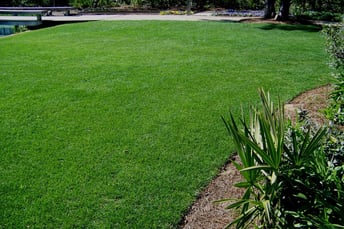

2. Perennial Ryegrass (Lolium perenne)
Best for: Quick lawn repairs, high-traffic areas, and overseeding.
Characteristics: Dark green, fine-textured, and forms a bunch-type growth (no spreading rhizomes).
Growth Habit: Germinates and establishes quickly (5-7 days).
Identification: Ridged leaves with a glossy backside, pointed leaf tip, and spike-like seedhead.
Strengths: Excellent wear resistance, fast growth, and moderate shade tolerance.
Weaknesses: Poor winter survival, no self-repair (does not spread like Kentucky Bluegrass), susceptible to diseases in humid conditions.
Which Cool-Season Grass Is Best for You?
✅ For High-Traffic Lawns → Tall Fescue or Perennial Ryegrass
✅ For Shady Areas → Fine Fescue (especially Creeping Red Fescue)
✅ For a Lush, Classic Lawn → Kentucky Bluegrass (often blended with Ryegrass or Fine Fescue)
✅ For Drought-Prone Lawns → Tall Fescue (deep root system helps it survive dry conditions)
✅ For Golf Course-Style Turf → Creeping Bentgrass (best for professional turf managers)
Need Help Establishing or Maintaining Your Lawn?
At Heartland Grounds, we specialize in lawn care, seeding, and turf management to ensure your yard stays lush and healthy. Whether you need help selecting the right grass type, overseeding for thicker turf, or ongoing professional maintenance, we’re here to help! Let’s make your lawn the best on the block! Contact us today for a free consultation!
5. Creeping Bentgrass (Agrostis palustris)
Best for: Golf courses, putting greens, and specialized turf areas.
Characteristics: Light bluish-green, fine-textured grass with high density.
Growth Habit: Highly stoloniferous (spreads aggressively along the surface).
Identification: Narrow leaves, panicle seedhead, and low-mowing tolerance (down to 0.125 inches).
Strengths: Excellent cold tolerance, tolerates close mowing, and good recovery from damage.
Weaknesses: Poor drought tolerance, requires high maintenance, and susceptible to disease under stress.
3. Fine Fescue (Festuca species)
Best for: Shady areas, low-maintenance lawns, and drought-prone sites.
Characteristics: Medium to light green, with fine-textured blades.
Growth Habit: Includes bunch-type and some spreading varieties (Creeping Red Fescue spreads via rhizomes).
Identification: Thin, soft blades with a slightly curled appearance.
Strengths: Excellent shade tolerance, good drought tolerance, quick germination.
Weaknesses: Poor wear resistance, slow recovery from damage, and may turn brown during drought.
4. Tall Fescue (Lolium arundinaceum)
Best for: High-traffic lawns, drought-prone areas, and low-maintenance landscapes.
Characteristics: Dark green, coarse-textured, and forms bunch-type clumps (some cultivars have rhizomes).
Growth Habit: Deep root system provides excellent drought and heat tolerance.
Identification: Wide leaf blades with prominent ridges and a broad collar.
Strengths: High wear resistance, good drought tolerance, thrives in full sun to partial shade.
Weaknesses: Slow recovery from damage, moderate low-temperature tolerance, susceptible to brown patch disease.
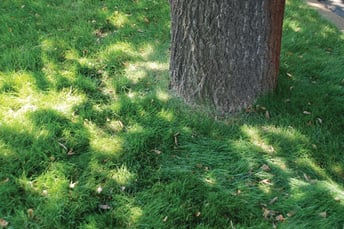

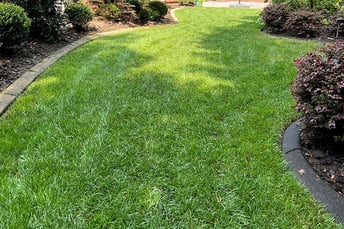

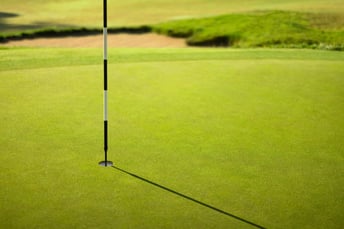

Heartland Grounds
Professional Care for Your Property
Proudly serving Coralville, North Liberty, Iowa City, Tiffin, & More
